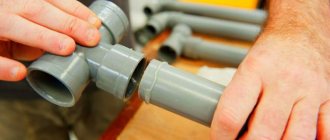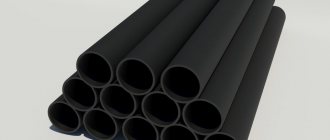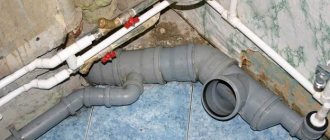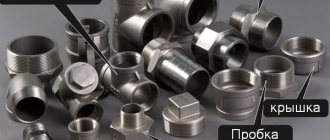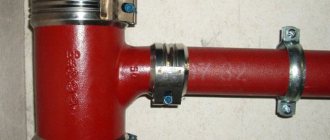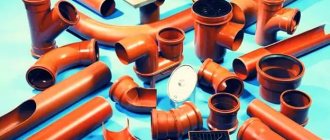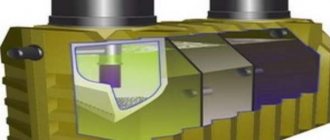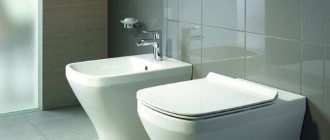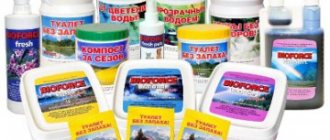Threaded pipe connections are perhaps the most common option for assembling them. You will not find a more proven or promoted way of creating water supply and communication systems.
And this popularity did not arise without a reason. Threads are really great for connecting pipes. It is relatively easy to cut (even with your own hands), can be maintained, modified, and also strengthened.
Thread on a water pipe
Let's look at all the nuances of threaded connections, their features and interesting details.
What are they?
What types of threaded connections exist? As with the use of threadless joints, there are two types:
- Detachable. This option is used in most cases.
- One-piece. When using this method, along with tightening the thread, welding is used, due to which unwinding of the thread is eliminated. This option is used if it is necessary to provide additional reliability of the connection.
There are two types of detachable threaded connections:
- drive;
- bidirectional thread.
The first option is used when it is necessary to connect two statically fixed pipes, one of which has a long threaded section, and the other a short one. The connection is made like this:
- a locknut and coupling are screwed onto a long section of thread;
- the coupling is driven onto a short section of thread, the coupling must be tightened to the end;
- the coupling must be secured with a locknut.
The use of a bidirectional coupling is necessary if pipes with different thread directions are connected.
Types of pipe connections
In general, all methods of connections between pipes can be divided into two types: threadless and threaded.
Threadless connections include:
- All types of welding (acetylene, hydrogen, propane, electric welding, inert gas welding, fusion of polymer pipes by heating, etc.);
- Bonding pipes using two-component adhesive, also sometimes called “cold welding”. This method is most often used for polymer pipe products, but can also be used for steel pipes if the pressure of the transported liquids or gases in them is not too high.
- Flange connections used in cases where the structure needs to be made detachable.
As for threaded pipe connections, they are carried out both by directly connecting pipe products to each other, and through threaded tees, adapters, taps, couplings and other additional devices.
To some extent, a union nut can be considered a special option for pipe connections, which, on the one hand, provides a threaded connection, and on the other, a threadless one. But it would be more correct to say that there is simply a combination of two different methods here.
Advantages and disadvantages
Let's figure out what are the advantages of threaded joints of pipeline elements and whether this method of connection has any disadvantages.
pros
Threaded pipe connections have many positive properties, these are:
- the ability to use elements from different materials for assembly (with the exception of soft polymer materials);
- the ability to make connections and, if necessary, cut threads yourself;
- sufficient level of tightness;
- the ability to quickly disassemble and reassemble the connection, this is necessary to carry out repairs or modifications.
Minuses
The main disadvantages of this type of docking are:
- lower level of tightness compared to welded joints;
- Over time, the connection weakens, so it needs periodic maintenance.
Over time, any connection on the thread weakens and a leak may occur in this place. The advantage is that the weakening is slow, and if the system is regularly maintained, the risk of leaks is minimal.
However, not every pipeline can be serviced; if the wiring is hidden, then checking the strength of the threaded connections will be problematic. Therefore, in this case, it is recommended to take additional security measures.
Advice! To eliminate the possibility of loosening the thread when laying a hidden pipeline (for example, when installing a heated floor system), it is recommended to install additional compression nozzles on the connection.
Malleable cast iron and connecting parts made from it
The most common ductile iron parts for connecting steel pipes and other pipeline parts are: A) straight couplings B) reducing couplings C) coupling nuts D) fittings E) locknuts E) plugs.
To completely seal the system with a threaded connection, it is necessary to use sealants, for example, gaskets. In addition to them, for other types of fastening additional parts are used. If it is necessary to connect the elements of the pipeline using flanges, that is, without a coupling, then in addition to gaskets, bolts are also needed.
When connecting risers at an angle, they use connecting parts made of ductile cast iron: straight and transition angles, tees, crosses.
Important! The connection will be of high quality and function flawlessly for a long time if, when installing parts, you use parts with straight ends that will be placed at right angles to the connecting parts.
You should pay attention to the threads on the parts, which should be free of burrs and clean.
A cast iron coupling has a low collar around the entire perimeter of the end circumference, which serves to increase the strength of the part, unlike its steel counterpart, which does not have such an element.
The quality of connections depends not so much on the sealing methods and materials, but on the craftsman and the quality of his work. If he is responsible, neat, has basic plumbing knowledge and skills in working with a wrench or pipe wrench, then you won’t find a better specialist. If you follow the basic rules for installing pipeline systems, the pipeline will function for many years. This can be confirmed by anyone who has at least once installed a pipeline system, even the shortest and simplest one.
Try it yourself, experiment and see that you are the best specialist in installing pipeline systems using the threaded method of connecting pipeline elements.
In what cases is it used?
When assembling pipelines for various purposes, threaded connections are often used. To make a joint, it is necessary to have a thread on the outer surface of the pipe end and an internal thread on the part being joined.
Advice! It is not recommended to cut an internal thread at the end of the pipe, since in this case the attached part will be located inside the pipeline, and this will reduce the diameter of the passage.
This type of docking is used to perform the following work:
- connection of two pipes; to make this joint, a connecting coupling is installed, which has internal threads on both sides;
- joining two elements of different diameters, this will require a special adapter coupling;
- turning the pipeline, in this case a fitting in the form of an angle is used;
- branching the pipeline; a tee or cross is used to connect an additional branch;
- creating a dead-end branch; if necessary, installing a plug on the pipe;
- connection of various devices using a threaded adapter fitting.
Non-curing sealants
They are produced in the form of thick and viscous pastes consisting of polymers and synthetic resins. This consistency allows them to provide high-quality sealing of connections and calmly withstand vibration loads. Such sealants are often used in combination with other sealants.
Important! Non-hardening sealants cannot be used in high-pressure systems - the composition will simply squeeze out of the thread. They also do not tolerate exposure to aggressive materials well.
Thread cutting
If the thread is already cut, then connecting the elements is very simple. However, in some cases you have to cut the thread yourself. To do this job you will need a tap and a die. The first tool is used for cutting internal threads, the second one cuts threads on the outside of the part. Select a tool depending on the following parameters:
- pipe material;
- their diameter;
- the type of thread that needs to be cut.
To complete the work you will need to perform the following operations:
- the pipe is bored through;
- a basic pass is performed;
- the tap is screwed in (or the die is screwed in) until the required thread length is obtained.
What to seal with
There are many sealants available for sealing threaded connections. Ribbon “fum”, linen, “tangit” - sometimes your eyes run wide from the choice. Recently, a new product has appeared - an anaerobic sealant for threaded joints (please do not confuse it with flax paste), which greatly simplifies the procedure.
Anaerobic sealant has a couple of significant disadvantages: 1. The parts being joined must be dry and clean - this can be a serious problem when repairing and replacing parts in a working system. 2. It takes time for the sealant to harden, albeit insignificantly, but this slows down the entire installation process. In addition, there is reason to believe that the connected parts cannot be disturbed in any way during subsequent repairs. In general, this solution is suitable for a beginner, for minor repairs. This material is not entirely suitable for a professional.
It should be noted: a good plumber will make a connection with any of the above sealants and there will be no leakage. We will focus on a time-tested material that is used by the vast majority of specialists: sanitary flax and paste for it
.
In general, flax can be used without investment paste, but it generally increases the reliability of the joint and simplifies the operation. Flax fibers tend to rot over time or dry out on hot water pipes - paste prevents these problems. An important property of the paste is its ability to hold pressure in loose threads.
The indisputable advantage of flax over other investment materials: parts can be untwisted a couple of turns without losing their tightness.
And this can be done even a few months after the initial installation! For example, the FUM tape does not tolerate backing at all, and the same can be said about dried anaerobic sealant.
Types of seals
If you plan to use a threaded connection to assemble pipes, then you must use additional sealing agents.
Linen
For sealing, a winding made of flax tow is used. Additionally, silicone or plumbing paste is used, this is necessary to protect the winding from drying out.
Advice! Flax tow has been used to seal joints for many years. But earlier, instead of plumbing paste, oil paint was used.
This is a cheap and reliable method of sealing, but it is not very convenient to use. The work is carried out like this:
- the necessary part of the tow is separated from the bunch;
- the separated bundle must be carefully smoothed; no twisting or kinks should be allowed on it;
- put the tow on the thread so that the middle of the bunch is at the top, then forcefully screw it onto the thread, turning clockwise, you need to wind both hanging “tails”;
- Apply plumbing paste, level, achieving uniform coverage;
- tighten the connection using a wrench.
Sealing tape
This is a more convenient modern sealing material. The work should be done like this:
- tear off a piece of the required length;
- wind the tape clockwise;
- tighten the connection using a wrench.
Advice! The only significant drawback of this sealing method is the high price of the sealing tape.
Methods for sealing threaded pipe connections
Sealing pipe connections is necessary to prevent leaks of liquids and gases. A high-quality sealant for threaded connections of water pipes will prevent leaks in the future.
In the case of threaded connections, sealing can be accomplished in several ways:
- Use of gaskets. This method requires sufficient thickness of pipe cuts at the ends. The pipe ends themselves usually do not provide a hermetically compressed connection, but the use of gaskets makes it possible to eliminate this problem. In particular, this sealing option is often used in connections with a union nut.
- Winding threads. With this method, the threads are sealed by tying with all kinds of winding materials: polymer threads and tapes, pipe compounds and other types of hardening sealants, sealing pastes and lubricants, natural or artificial fibers, etc.
- Sealing through deformation of materials. This option is used in low-pressure plastic pipelines connected using threads. A plastic pipe equipped with an external thread is screwed into another with a stop, which has an internal thread. When screwed in this way, the plastic undergoes deformation and fills the intermediate threaded space well, leaving virtually no gaps.
As for connecting high-pressure pipelines, a conical type of threaded pipe connections is usually used here. With this method, as it is screwed in, one pipe is pressed against the other more and more tightly, leaving almost no intermediate gaps between the threaded grooves. However, such pipes still require additional sealing, and especially durable types of synthetic sealants are used here.
How to choose a pipe connection
The main reason for pipeline failure is the incorrect selection of connectors. Therefore, during installation, elements should be selected according to the purpose of their use, taking into account many different criteria:
- compatibility with the work environment;
- type of hydraulic pipeline;
- pressure loads;
- working environment consumption;
- thermal load;
- operating conditions of the hydraulic system;
- corrosive effects.
A particularly important criterion is the resistance of fasteners to corrosion processes. For example, the pipelines of some metal processing machines are regularly exposed to grinding dust and cutting fluids, and installations in the medical and food industries can suffer from aggressive environments. In such a situation, connectors made of plain steel, including those with galvanic coating, cannot be used. Stainless steel products will be more effective as they can reliably protect the hydraulic system from corrosion.
To select the correct pipe threaded connections, the latest standards and regulations must be taken into account. When purchasing, it is important to take into account the technical requirements for a specific pipeline, as well as use the experience of using the selected product accumulated by the manufacturer.
Source
